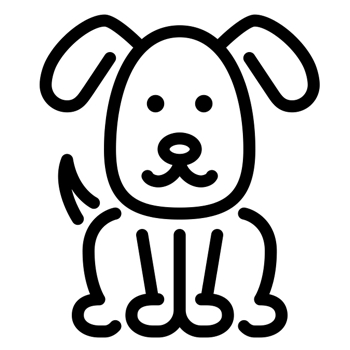Pugmatian

The small and boisterous Pug and the lean and playful Dalmatian have joined together to create the sweet Pugmatian – an affectionate companion animal that loves to interact with the whole family. Most Pugmatians more closely resemble Pugs, with their wrinkled face and short stature, although their Dalmatian ancestry is often apparent in their coat with black spots dotted around their fur.
Good socialisation and consistent training can result in a well-balanced and loyal pet dog, although some individuals may develop separation anxiety. With moderate activity requirements and a sensible head on their shoulders, the Pugmatian makes a good pet for a family with children.
About & History
An exceedingly rare mix breed it is unlikely you have ever met a Pugmatian, a cross between a Pug and a Dalmatian. It is thought that this cross-breed has only been in existence for the last 10 to 20 years and there are a very limited number of them worldwide.
With only a brief and limited history available for the Pugmatian, we can look to their parents to get a better idea of how their ancestors lived. The Pug is a small dog that likely originated in the Orient some time two thousand years ago. It is known that Chinese aristocrats bred them and saw them as valuable companion animals. During the 14th and 15th centuries, there are numerous artworks depicting the Pug, who was looked highly upon by society. Never really used as a working animal, to this day, the Pug remains a companion and a show dog.
The Dalmatian has a somewhat debated history though most agree they too have been around since ancient times. Dogs of a similar appearance appeared in depictions in ancient Egyptian tombs, though their name derives from a historical area in Croatia (Dalmatia). Traditionally used as ‘carriage dogs’, Dalmatians would accompany horse and carts, whether they were gypsy caravans or the chariots of noblemen. They would run alongside the horses, clearing the road ahead. A versatile animal, they have also been used throughout the years as hunting dogs, guard dogs and even circus performers.
Appearance
As the parents of the Pugmatian are so distinctly different looking, there is a wide variability when it comes to their appearance. Broadly speaking, they are a small to medium sized breed that tends to possess a face that is more reminiscent of their Pug parent. Their head retains the brachycephalic Pug features with wide brown eyes and a small, dark nose. They have a rounded skull and mild facial wrinkling, which is more prominent in the forehead region. Their ears are velvety and triangular in shape, flopping forwards away from their face.
Unlike the Dalmatian, who is universally known for their white coat with black spots, the Pugmatian can have a wide variety of coat colours and patterns. Their short coat can be black, brown, fawn, white or sable and may or may not have spots, which can appear in any location.
Taking more after their Pug parent when it comes to size, most fully grown Pugmatians are between 33cm and 40cm, with the females often standing a few cms shorter. They weigh from 9kg to 13kg, although some individuals may be noticeably larger than this.
Character & Temperament
With both parents having made names for themselves as superb companion animals, the Pugmatian is a loving and affectionate pet that thrives in the presence of people. At times, their reliance on human companionship can pose an issue, as they may develop separation anxiety. This means that they are not well-suited to those that spend a lot of time away from the home and may be best off in a house where there is always someone around. They are friendly with people of all ages and can make fantastic little friends for children.
Intelligent and curious, the Pugmatian relishes the opportunity to learn and to be active. They enjoy any form of mental stimulation, whether it be canine puzzles or agility courses in the great outdoors. A brave dog that is loyal and dedicated to its family, the Pugmatian makes a natural watchdog. However, they are typically not hostile enough to make it as a guard dog and should not be used for this purpose.
Trainability
At times stubborn, trainers need to possess a good deal of patience and understanding when it comes to the Pugmatian. While they have the brains to master a large number of tasks, they do not always feel like ‘playing ball’. To combat this, aim to keep training sessions relatively short and always diverse and entertaining.
Positive reinforcement is the key to keeping these guys on side as any form of punishment or criticism will likely incur more obstinate behaviour. Keeping them on your side and rewarding them when they get things right will enable them to develop over time.
Owners should focus on preventing separation anxiety, which is a known issue in the Pugmatian. Crate training is a good start during puppyhood and all family members should make it a rule to not overly fuss the dog or reward any clingy behaviour. Particularly in early life when the dog is still developing, owners should consider the use of an animal behaviourist to assist them.
Health
It is generally accepted that by mixing pure breeds of dogs we can reduce the occurrence of certain genetic diseases within the population. Given the fact that the Pugmatian is a relatively new mixed-breed, there are no published studies on their health, so we need to look to their parents to predict potential issues.
BOAS
Brachycephalic Obstructive Airway Syndrome, or BOAS, affects dogs with a particular ‘short-nosed’ conformation, such as the Pug, Shih Tzu or Bulldog. These dogs have been ‘shrunken down’ so that their skeleton is no longer large enough to support their soft tissues, often resulting in difficulty breathing.
With responsible breeding, the incidence of BOAS in a community can be reduced and the introduction of the Dalmatian into the Pug line can help to dramatically improve the conformation of the puppies, meaning any BOAS inherited should be mild.
Urinary Stones
As the Dalmatian is genetically prone to developing urate stones and the Pug is not uncommonly affected by bladder stones in general, it would be prudent to assume the Pugmatian should be closely monitored for stone development. There are several things that owners can do to prevent stone development, which include the feeding of certain diets and increasing water intake.
Deafness
Studies have shown that up to 30% of Dalmatians are deaf in at least one ear and as this is caused by a genetic defect, the Pugmatian population will have to be monitored closely for any inherited deafness. Bilateral deafness in dogs is significant as it dramatically increases their risks of being involved in accidents, such as road traffic collisions.
Hypothyroidism
An underactive thyroid can result in a myriad of symptoms, including sluggishness, weight gain and a slow heartbeat. Thankfully, this hormonal condition is easily controlled with daily medication and the majority of dogs have an excellent prognosis.
Exercise and Activity Levels
While the Dalmatian is a highly active dog who enjoys running and participating in canine sports, the Pug is known for being quite idle and is often limited by their conformation when it comes to exercise. The Pugmatian tends to fall somewhere in the middle of these two extremes. As long as the Pugmatian has not inherited severe BOAS (Brachycephalic Obstructive Airway Syndrome), they can tolerate a good amount of exercise.
A couple of walks that last between 30 and 45 minutes should be enough for your Pugmatian each day and they also enjoy the opportunity to play games, such as fetch, flyball and frisbee.
Grooming
The very short coat of the Pugmatian is incredibly easy to groom and really only requires a quick brush down every week or so. They shed a moderate amount, though this will increase at certain times of the year, when it is best to groom them more frequently to remove dead fur.
The pendulous ears of the Pugmatian should be checked once or twice a week for any early signs of infection. If they are prone to waxy build-ups, they should be cleaned out with a canine ear cleaner. After any activity when the ears get wet, such as bathing or swimming, the canals must be thoroughly dried out.

